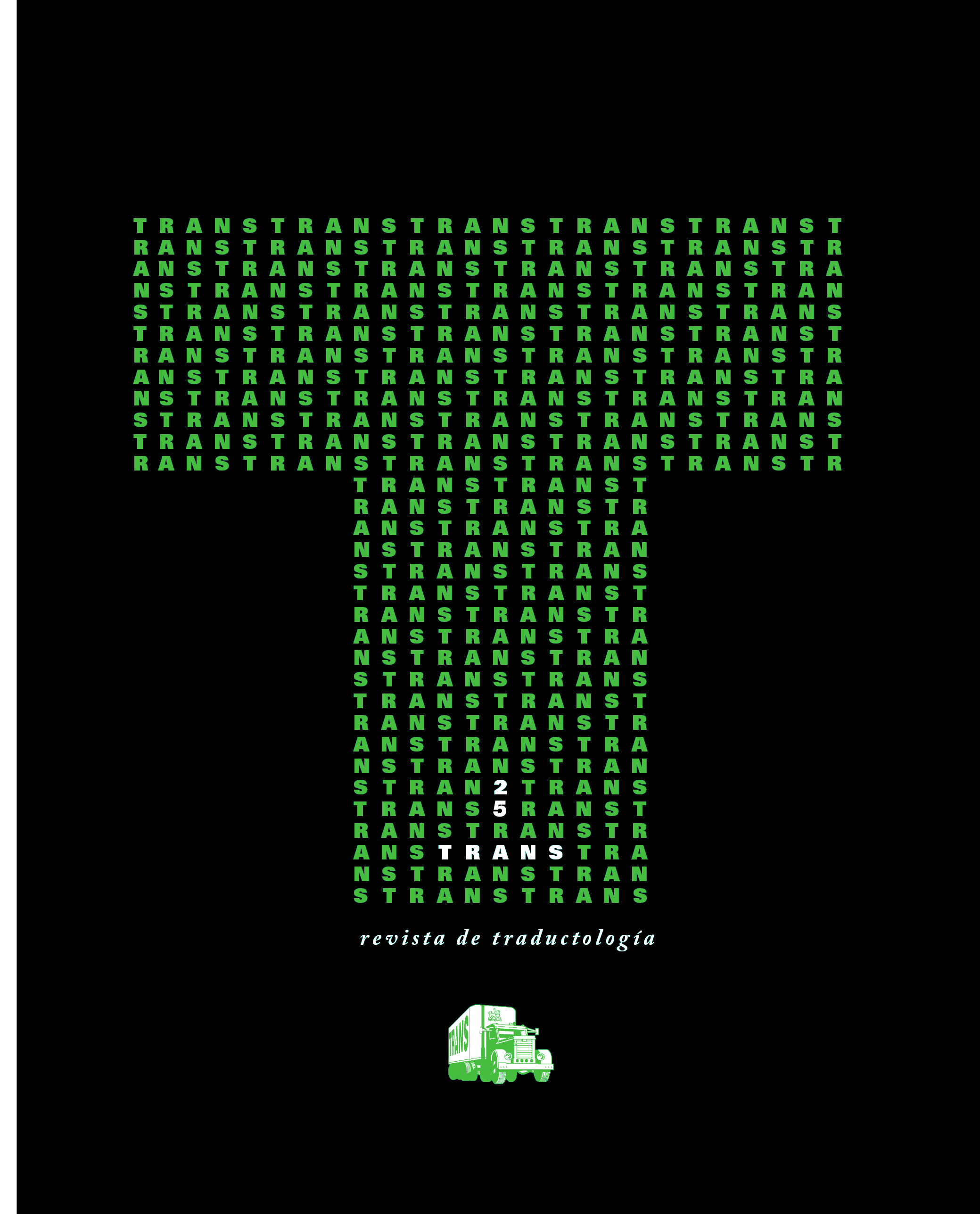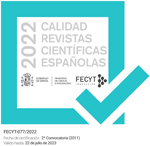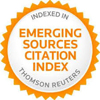Memoria de trabajo e interpretación simultánea: Propuesta de un test adaptado de retención de palabras
DOI:
https://doi.org/10.24310/TRANS.2021.v1i25.7893Palabras clave:
cognición, memoria de trabajo, capacidad de retención, interpretación simultánea, conocimiento de lengua extranjeraResumen
Las relaciones entre memoria de trabajo y eficiencia en la actividad interpretativa han sido evaluadas con diferentes instrumentos de exploración psicolingüística. Se propone en este estudio una versión adaptada de un test de retención de palabras con dos versiones: una en lengua nativa, español, y otra en lengua extranjera, francés, administrada a sujetos que se inician en la práctica de la interpretación simultánea. Se aportan fundamentos metodológicos y algunos resultados que confirmarían la validez de la prueba a la hora de valorar capacidades de memoria de trabajo implicadas en la referida práctica.
Descargas
Métricas
Publicación Facts
Perfil de revisores N/D
Información adicional autores
Indexado: {$indexList}
-
Indexado en
- Sociedad Académica/Grupo
- N/D
- Editora:
- Universidad de Málaga
Citas
AITCHISON, Jean (1989): Words in the mind: An introduction to the mental lexicon, Cambridge, MA: Blackwell.
AUTORA (2019): «A comparative assessment of listening span and self-efficacy in simultaneous interpreting training», The interpreter and translator trainer (under review).
AUTORA y AUTOR (2019): «Adaptación de un test de retención auditiva de palabras (‘listening span’) como indicador de eficiencia en la práctica interpretativa», comunicación presentada al VII Congreso Internacional Entreculturas, Málaga.
BADDELEY, Alan D. (1996). «Exploring the central executive», Quarterly Journal of Experimental Psychology, 49A, 5-28.
BADDELEY, Alan D. y Graham HITCH (1974): «Working memory», en Gordon H. Bower (ed.), The psychology of learning and motivation, New York: Academic Press, 47-89.
BANDURA, Albert (1995): Self-Efficacy in Changing Societies, Cambridge: Cambridge University Press.
CASPARI, Isabelle, Stanley R. PARKINSON, Leonard L. LAPOINTE, y Richard C. KATZ (1998), «Working memory and aphasia», Brain and Cognition, 37, 205-223.
CHRISTOFFELS, Ingrid (2004): Cognitive studies in simultaneous interpreting, Ipskamp/Enschede: PrintPartners.
DANEMAN, Meredith y Patricia A. CARPENTER (1980), «Individual differences in working memory and reading», Journal of Verbal Learning and Verbal Behavior, 19/4, 450-466.
DARÒ, Valeria y Franco FABBRO (1994): «Verbal memory during simultaneous interpretation: Effects of phonological interference», Applied Linguistics, 15/4, 365-381.
HODÁKOVÁ, So?a (2009): Pamät’ v simultánnom a konzekutívnom tlmo?ení. [Memory in simultaneous and consecutive intepreting], Unpublished Ph.D. dissertation. Nitra, Konštantín Filozof University.
IVANOVA, Maria V. y Brooke HALLOWELL (2014): «A new modified listening span task to enhance validity of working memory assessment for people with and without aphasia», Journal of Communication Disorders, 52, 78-98.
JIMÉNEZ IVARS, Amparo, Daniel PINAZO CALATAYUD y Marta RUIZ I FORÉS (2014): «Self-efficacy and language proficiency in interpreter trainees», The Interpreter and Translator Trainer, 8/2, 167-182.
KÖPKE, Barbara y Jean-Luc NESPOULOUS (2006): «Working memory performance in expert and novice interpreters», Interpreting, 8/1, 1-23.
LEE, Sang-Bin (2014): «An Interpreting Self-Efficacy (ISE) scale for undergraduate students majoring in consecutive interpreting: construction and preliminary validation», The Interpreter & Translator Trainer, 8, 183-203.
LIU, Minhua, Diane L. SCHALLERT y Patrick J. CARROLL (2004): «Working memory and expertise in simultaneous interpreting», Interpreting, 6/1, 19-42.
LÓPEZ-HIGES, Ramón, Susana RUBIO, María Teresa MARTÍN-ARAGONESES, David DEL RÍO y Gema MEJUTO (2012): «Assessment of grammatical comprehension in normal and pathological aging: A summary of the results obtained with ECCO and ECCO_Senior tests», International Journal of Psychological Research, 5/1, 94-106.
MUÑOZ MARTÍN, Ricardo (ed.) (2014): Minding translation. Con la traducción en mente, MONTI Monografías de Traducción e Interpretación. Número especial 1.
NORDET, Lilian y Lara VOEGTLIN (1998): Les tests d’aptitude pour l’interpétation de conference. La mémoire. Mémoire pour l’obtention du Diplôme de Traducteur. Genève: Université de Genève.
PADILLA BENÍTEZ, Presentación (1995). Procesos de memoria y atención en la interpretación de lenguas. Tesis Doctoral, Granada, Universidad de Granada.
PADILLA, Presentación; María Teresa BAJO, José Juan CAÑAS, and Francisca PADILLA (1995): «Cognitive processes of memory in simultaneous interpretation», en Jorma Tommola (ed.), Topics in Interpreting Research, Turku: University of Turku Press, 61-71.
SHREVE, Gregory M. y Erik ANGELONE (eds.) (2010): Translation and Cognition, Amsterdam/Philadelphia: John Benjamins.
TIMAROVÁ, Šárka (2008) : «Working memory and simultaneous interpreting», en Pieter Boulogne (ed.), Translation and Its Others. Selected Papers of the CETRA Research Seminar in Translation Studies 2007, http://www.kuleuven.be/cetra/papers/papers.html, 1-28.
TIMAROVÁ, Šárka, Ivana ?E?KOVÁ, Reine MEYLAERTS, Erik HERTOG, Arnaud SZMALEC y Wouter DUYC (2014): «Simultaneous interpreting and working memory executive control», Interpreting, 16/2, 139-168.
TURNER, Marilyn L. y Randall W. ENGEL (1989): «Is working memory task dependent?», Journal of Memory and Language, 28/2, 127-154.
TZOU, Yeh-Zu, Zohreh R. ESLAMI, Hsin-Chin CHEN y Jyotsna VAID (2012) : «Effect of language proficiency and degree of formal training in simultaneous interpreting on working memory and interpreting performance: Evidence from Mandarin-English speakers», International Journal of Bilingualism, 16/2, 213-227.
Publicado
Cómo citar
Número
Sección
Licencia
Todos los contenidos publicados en TRANS. Revista de Traductología están sujetos a la licencia Creative Commons Reconocimento-NoComercia-Compartirigual 4.0 cuyo texto completo puede consultar en <http://creativecommons.org/licenses/by-nc-sa/4.0>
Se pueden copiar, usar, difundir, transmitir y exponer públicamente, siempre que:
- Se cite la autoría y la fuente original de su publicación (revista, editorial y URL de la obra).
- No se usen para fines comerciales.
- Se mencione la existencia y especificaciones de esta licencia de uso.
- Compartir Igual — Si remezcla, transforma o construye sobre el material, debe distribuir sus contribuciones bajo la misma licencia que el original.
Los derechos de autor son de dos clases: morales y patrimoniales. Los derechos morales son prerrogativas perpetuas, irrenunciables, intransferibles, inalienables, inembargables e imprescriptibles. De acuerdo con la legislación de derechos de autor, TRANS. Revista de Traductología reconoce y respeta el derecho moral de los autores/as, así como la titularidad del derecho patrimonial, el cual será cedido a la Universidad de Málaga para su difusión en acceso abierto. Los derechos patrimoniales, se refieren a los beneficios que se obtienen por el uso o divulgación de las obras. TRANS. Revista de Traductología se publica en open access y queda autorizada en exclusiva para realizar u autorizar por cualquier medio el uso, distribución, divulgación, reproducción, adaptación, traducción o transformación de la obra.
Es responsabilidad de los autores/as obtener los permisos necesarios de las imágenes que están sujetas a derechos de autor.
Los autores/as cuyas contribuciones sean aceptadas para su publicación en esta revista conservarán el derecho no exclusivo de utilizar sus
contribuciones con fines académicos, de investigación y educativos, incluyendo el auto-archivo o depósito en repositorios de acceso abierto de cualquier tipo.













21.png)
